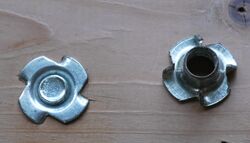Engineering:T-nut
A T-nut, T nut, or tee nut (also known as a blind nut,[1] which can however also refer to a rivet nut or an insert nut, and likewise drive-in nut[2]) is a type of nut used to fasten a wood, particle or composite materials workpiece, leaving a flush surface.
It has a long, thin body and a flange at one end, resembling a T in profile. The flanges of T-nuts often have hooks or serrations on the prongs that dig into a wooden work piece as the bolt is tightened from the opposite side of the piece, providing better retention.
In 1969, the first four-prong T-nut with an eight-sided base was patented. Unlike standard round base T-nuts, eight-sided T-nuts can be fed efficiently and reliably via machine. The eight-sided T-nut base has become the standard configuration for T-nuts inserted by machine.[3][4][5]
See also
- T-slot nuts, which are used in work-holding in machine tools. T-slot nuts fit in T-section slots in the machine work-table and are used in conjunction with studs and clamps to provide flexible means of holding workpieces in place.
- Weld nuts, which are similar in appearance to t-nuts. They lack the prongs which penetrate into wood. Weld nuts are usually spot-welded into place on metal.
References
- ↑ Airfield Models - Threaded Fasteners used in Model Airplanes
- ↑ 4 PRONG DRIVE IN NUT FOR WOOD (T-NUT) ZINC PLATED Kays Fasteners, accessed 2019-09-09.
- ↑ Leistner, Walter Hermann, "Fastener member", US patent 3480061, issued 1969-11-25.
- ↑ Our history, archived from the original on 2009-01-05, https://web.archive.org/web/20090105191714/http://www.specialtyfasteners.net/history.htm, retrieved 2009-10-21.
- ↑ About Sigma, http://www.sigmatool.com/information/about, retrieved 2009-10-21.
de:Mutter (Technik)#Einschlagmutter
 |


